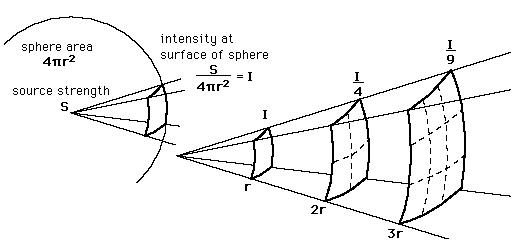|
|
Supernovae
Try this!
Type Ia supernovae all emit the same amount of energy. Some
appear brighter to us than others because they are at different
distances from Earth. Astronomers can use these facts to determine
distances to these supernovae, and so can you!
Astronomers find that if all Type Ia supernovae were at a distance of
100,000 parsecs, they would have a peak magnitude of +1 (about as
bright as the star Aldebaran). They treat this distance and magnitude
as a "standard". The actual
distance to a particular supernova is found by first comparing its peak
magnitude with this standard. Now remember that the magnitude scale
is set up so that each difference of 5 magnitudes (e.g. between magnitude
+1 and +6) represents a difference in brightness of 100 times. A
difference of 10 magnitudes represents a difference in brightness of
100 x 100 (= 1002), or 10,000 times, and a difference of
15 magnitudes is a difference in brightness of 1003 or
1,000,000 times.
The inverse square law compares the brightness of objects with their
distances. An object twice as far away from you appears 22
or 4 times fainter, and one 3 times farther appears 32 or 9
times fainter. Likewise, the inverse square law tells us
that we can find the difference in distance by taking the square root
of the difference in brightness. So by comparing the brightness of two
objects, we can determine their relative distances.
Then if we know the actual distance to one of the objects, we can
determine the distance to the other. With our standard magnitude of
+1 at a distance of 100,000 parsecs, we can thus determine distances
to Type Ia supernovae.

|
An illustration of the Inverse Square Law.
The Intensity (or brightness) of a source of light falls off as
the inverse square of the distance from the source. This is because
the light's intensity can be thought of as being spread out uniformly
over the surface of a sphere. At greater distances, the sphere is
larger, so the same amount of light is spread over a larger area.
This makes the light source appear dimmer as the distance from it
increases.
|
Example: A type Ia supernova has a peak magnitude of +11. How
far away is it ?
Solution: This supernova is 10 magnitudes fainter than our
standard supernova of magnitude +1. Since each difference of 5
magnitudes gives a factor of 100 times fainter in brightness,
our supernova is (10/5) = 2 of these factors fainter than our
standard. It is thus 100 x 100 (= 1002), or 10,000
times fainter than our standard. We next use the inverse square law to
determine how much farther away it is than our standard. We can
find the difference in distance by taking the square root of the
difference in brightness. We find our supernova is
 farther away than our standard.
Recall that the standard magnitude for supernovae is for supernovae
at a distance of 100,000 parsecs. So our supernova
is at a distance of
farther away than our standard.
Recall that the standard magnitude for supernovae is for supernovae
at a distance of 100,000 parsecs. So our supernova
is at a distance of
 Because the distances to supernovae are usually large, astronomers often express them in Megaparsecs (= 1,000,000 parsecs), which is
abbreviated Mpc. So our supernova is 10 Mpc away!
Because the distances to supernovae are usually large, astronomers often express them in Megaparsecs (= 1,000,000 parsecs), which is
abbreviated Mpc. So our supernova is 10 Mpc away!
Now try some yourself:
For each of these observed magnitudes of type Ia supernova, determine
their distances:
(Note: Don't use commas or spaces in your answers.)
This activity is based on an idea by Cheryl Carter, Bladensburg High
School, Bladensburg, MD.
|
